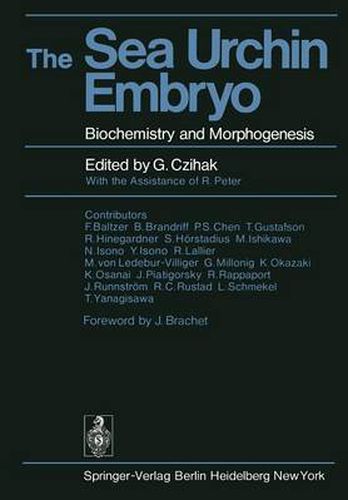Readings Newsletter
Become a Readings Member to make your shopping experience even easier.
Sign in or sign up for free!
You’re not far away from qualifying for FREE standard shipping within Australia
You’ve qualified for FREE standard shipping within Australia
The cart is loading…






This title is printed to order. This book may have been self-published. If so, we cannot guarantee the quality of the content. In the main most books will have gone through the editing process however some may not. We therefore suggest that you be aware of this before ordering this book. If in doubt check either the author or publisher’s details as we are unable to accept any returns unless they are faulty. Please contact us if you have any questions.
Sea urchin eggs are objects of wonder for the student who sees them for the first time under the microscope. The formation of the fertil ization membrane after insemination, the beauty of mitotic cleavage, the elegant swimming of embryos, remain an esthetic pleasure even for the eyes of seasoned investigators. But sea urchin eggs have other, more practical, advantages: they lend themselves to surgical operation without difficulty and they heal perfectly; they can be obtained in very large amounts and represent thus an extremely favorable material for biochemists and molecular embryologists. It is not surprising that, in view of these exceptional advantages, sea urchin eggs have attracted the interest of innumerable biologists since O. HERTWIG discovered the fusion of the pronuclei (amphimixy), in Paracentrotus lividus, almost a century ago. The purpose of the present book is to present, in a complete and orderly fashion, the enormous amount of information which has been gathered, in the course of a hun dred years of sea urchin embryology. JOSEPH NEEDHAM, in 1930, was still able to present all that was known, at that time, on the biochemistry of all possible species of developing eggs and embryos in his famous Chemical Embryology (Cambridge University Press) . It would no longer be possible for one man to write a modern version of what was a Bible for the young embryologists of forty years ago.
$9.00 standard shipping within Australia
FREE standard shipping within Australia for orders over $100.00
Express & International shipping calculated at checkout
This title is printed to order. This book may have been self-published. If so, we cannot guarantee the quality of the content. In the main most books will have gone through the editing process however some may not. We therefore suggest that you be aware of this before ordering this book. If in doubt check either the author or publisher’s details as we are unable to accept any returns unless they are faulty. Please contact us if you have any questions.
Sea urchin eggs are objects of wonder for the student who sees them for the first time under the microscope. The formation of the fertil ization membrane after insemination, the beauty of mitotic cleavage, the elegant swimming of embryos, remain an esthetic pleasure even for the eyes of seasoned investigators. But sea urchin eggs have other, more practical, advantages: they lend themselves to surgical operation without difficulty and they heal perfectly; they can be obtained in very large amounts and represent thus an extremely favorable material for biochemists and molecular embryologists. It is not surprising that, in view of these exceptional advantages, sea urchin eggs have attracted the interest of innumerable biologists since O. HERTWIG discovered the fusion of the pronuclei (amphimixy), in Paracentrotus lividus, almost a century ago. The purpose of the present book is to present, in a complete and orderly fashion, the enormous amount of information which has been gathered, in the course of a hun dred years of sea urchin embryology. JOSEPH NEEDHAM, in 1930, was still able to present all that was known, at that time, on the biochemistry of all possible species of developing eggs and embryos in his famous Chemical Embryology (Cambridge University Press) . It would no longer be possible for one man to write a modern version of what was a Bible for the young embryologists of forty years ago.